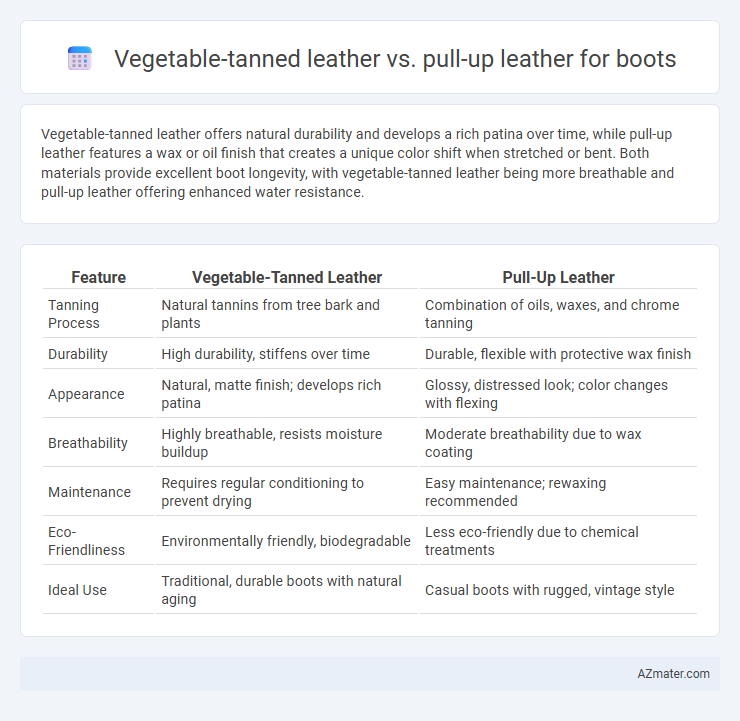Vegetable-tanned leather offers natural durability and develops a rich patina over time, while pull-up leather features a wax or oil finish that creates a unique color shift when stretched or bent. Both materials provide excellent boot longevity, with vegetable-tanned leather being more breathable and pull-up leather offering enhanced water resistance.
Table of Comparison
| Feature | Vegetable-Tanned Leather | Pull-Up Leather |
|---|---|---|
| Tanning Process | Natural tannins from tree bark and plants | Combination of oils, waxes, and chrome tanning |
| Durability | High durability, stiffens over time | Durable, flexible with protective wax finish |
| Appearance | Natural, matte finish; develops rich patina | Glossy, distressed look; color changes with flexing |
| Breathability | Highly breathable, resists moisture buildup | Moderate breathability due to wax coating |
| Maintenance | Requires regular conditioning to prevent drying | Easy maintenance; rewaxing recommended |
| Eco-Friendliness | Environmentally friendly, biodegradable | Less eco-friendly due to chemical treatments |
| Ideal Use | Traditional, durable boots with natural aging | Casual boots with rugged, vintage style |
Introduction to Boot Leather Types
Vegetable-tanned leather, crafted using natural tannins from plant extracts, offers a firm structure and develops a rich patina with use, ideal for durable boots. Pull-up leather, treated with oils and waxes, provides a supple, distressed look that enhances character through creasing and stretching. Both types emphasize longevity and aesthetic appeal, catering to different preferences in boot craftsmanship and wearability.
What is Vegetable-Tanned Leather?
Vegetable-tanned leather is crafted using natural tannins extracted from tree bark, leaves, and other plant materials, creating a durable and environmentally friendly alternative to chrome-tanned leather. This tanning method enhances the leather's ability to develop a rich patina over time, making it highly sought after for premium boot construction due to its stiffness, breathability, and long-lasting qualities. Boots made from vegetable-tanned leather tend to age gracefully, offering improved comfort and character as they mold to the wearer's foot.
What is Pull-Up Leather?
Pull-up leather is a type of full-grain leather treated with natural oils and waxes, designed to develop a unique patina and rich color variations with wear and bending. Unlike vegetable-tanned leather, which undergoes a slow tanning process using tannins from plant materials, pull-up leather features an additional finishing process that enhances its softness and water resistance while maintaining durability. This makes pull-up leather particularly popular for boots, offering a rugged yet supple texture that ages beautifully over time.
Leather Tanning Processes Compared
Vegetable-tanned leather uses natural tannins from tree bark and plants, resulting in a firm, durable material that develops a rich patina over time, ideal for boots requiring structure and longevity. Pull-up leather, typically chrome-tanned and infused with oils or waxes, offers a soft, flexible feel with a characteristic color variation that appears when the leather is stretched or pulled. The tanning choice impacts boot performance: vegetable tanning emphasizes rigidity and natural aging, while pull-up leather prioritizes a supple texture and aesthetic appeal with distress marks.
Durability and Longevity: Which Leather Lasts Longer?
Vegetable-tanned leather is known for its firmness and ability to develop a rich patina over time, offering exceptional durability that withstands wear and tear, making it ideal for long-lasting boots. Pull-up leather, treated with oils and waxes, provides flexibility and water resistance but may show scratches and color changes more quickly, impacting its longevity. In terms of lasting power, Vegetable-tanned leather generally outperforms Pull-up leather due to its natural tanning process and structural integrity.
Appearance and Patina Development
Vegetable-tanned leather for boots offers a natural, rich appearance that deepens in color and develops a unique patina over time through exposure to sunlight and oils. Pull-up leather features a wax or oil finish that creates a distinctive color variation and highlights creases when stretched, producing a vintage, distressed look with wear. Both types enhance the boot's aesthetic; vegetable-tanned leather evolves with a smooth, warm patina while pull-up leather emphasizes rugged character and texture changes.
Comfort and Flexibility in Boots
Vegetable-tanned leather offers a firm yet breathable structure, providing excellent comfort as it molds naturally to the foot over time, enhancing fit and support. Pull-up leather, treated with oils and waxes, delivers increased initial flexibility, allowing boots to adapt quickly to foot movements while maintaining a supple feel. Both leathers improve comfort, but vegetable-tanned leather excels in long-term molding, whereas pull-up leather prioritizes immediate flexibility and a softer break-in period.
Environmental Impact and Sustainability
Vegetable-tanned leather is more environmentally friendly due to its use of natural tannins from tree bark and plants, reducing chemical pollutants and enhancing biodegradability. Pull-up leather, often derived from aniline or semi-aniline leather treated with oils and waxes, may involve synthetic additives that can affect recyclability and increase environmental footprint. Choosing vegetable-tanned leather for boots supports sustainable leather production by minimizing toxic waste and promoting renewable resources.
Maintenance and Care Requirements
Vegetable-tanned leather requires regular conditioning with natural oils or leather balms to prevent drying and cracking, while pull-up leather benefits from minimal moisture exposure and occasional light conditioning to maintain its characteristic distressed look. Both types demand air drying away from direct heat if wet, but vegetable-tanned leather may need more frequent maintenance to preserve its firmness and aging properties. Proper storage in a cool, dry place and the use of leather protectants extend the lifespan and appearance of both vegetable-tanned and pull-up leather boots.
Which Leather is Best for Your Boots?
Vegetable-tanned leather offers durability and a natural aging process that develops a rich patina, making it ideal for boots that prioritize long-lasting strength and character. Pull-up leather provides a unique aesthetic with its wax-enriched surface that lightens and darkens when stretched, offering a rugged, vintage look perfect for fashion-forward or casual boots. Choosing the best leather depends on your preference for natural durability and aging in vegetable-tanned leather versus the distinctive, distressed appearance and softness of pull-up leather.

Infographic: Vegetable-tanned leather vs Pull-up leather for Boot
 azmater.com
azmater.com